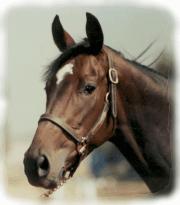A Horse, of Course with Don Blazer |
If you enjoy learning about horses, then you'll love our online courses. Each month you'll find a new column on our web site. We hope you'll enjoy it, and maybe e-mail us with questions or suggestions for other columns. A Horse, Of Course is a monthly column syndicated by Success Is Easy. If you like the column, call your local newspaper, or local horse publication and ask them to subscribe by contacting Success Is Easy. |
Train Horses the "Natural" Way - Become the Alpha Horse Don Blazer copyright©2012 |

“Intimidation” is today’s
primary system for training horses. Intimidation can be mild, moderate or abusive. It can be called “old-time training,” “natural horsemanship” or “classic dressage.” Argue about what it is and what it is called all you want…it’s an undeniable fact. The proof that it is a fact is confirmed by all the efforts to find a new and more acceptable way of describing horse training. From the earliest writings (Xenophon, if you will) there have been thousands of suggestions that horse training could be gentler, kinder, more caring. Behaviorists want to make horse training scientific and “natural horsemanship” advocates want you to believe it can be done without force by communicating with the horse in the horse’s natural world. (They refuse to recognize there is plenty of force used in the horse’s natural world to communicate a request.) Science has given us new words and concepts to describe what has been done in horse training even before there were behaviorists. The use of “successive approximation” is just the praising for any effort to comply and the repeating of a cue to elicit a specific response; a new description for a tried and true technique. There is nothing “natural” about a horse carrying a rider or pulling a cart, so there is actually nothing “natural” about “natural horsemanship”. Use of the horse’s natural instincts to aid in getting a specific response is as old as Xenophon. All the same intimidation techniques are use, just with a different name. A whip is no longer a whip (sinister), but is a stick and string (harmless.) There is nothing new or different about natural horsemanship; it’s just has “marketing appeal.” I’m not advocating “intimidation”; just the opposite: I’m simply saying that we have to recognize it as a fact. It is the principle way of training horses because training starts with getting the horse’s respect. Respect evolves from some kind of fear…minor, perceived, imagined or learned. The horse is a herd animal, always seeking approval of peers and happiest when being praised. The horse wants to remain in the herd. (Isn’t it interesting that those two things are the major objectives of humans within the human herd.) Understanding that, earning the horse’s respect should come from only one kind of fear…the horse’s fear that he will no longer be a part of the herd. If you do that, then you can provide the horse with the feeling of acceptance and the enjoyment of praise. The only possible way to eliminate intimidation from training requires you establish yourself as the horse’s herd leader…the alpha horse if you will. To be the herd leader and gain the respect of one or more horses in your herd, you must do two things: 1. Make the horse feel secure and comfortable believing you will provide protection, and 2. Confront unacceptable behavior. It is in confronting unacceptable behavior that we must be careful to avoid allowing intimidation back into the process. Confrontation is a requirement of learning. You make a request and the horse makes a response. If the response is not the one you wanted, you must confront the mistake immediately…not with intimidating force, but with a “No, that is not the correct response.” The confrontation can be as simple as stopping all movement, or riding through poor or misbehaving efforts. If confrontation is not forthcoming the horse can only conclude the response was acceptable. In training without intimidation, we are going to have to accept several things: 1. The training process will be much slower. (That can be a good thing for many reasons.) 2. We need to set learning goals much lower. If we can accept the smallest degree of improvement as our goal, then the horse will have “successful” training sessions every session. 3. We cannot criticize the horse. If the horse has faults you can’t accept, get a new horse. If the horse accepts you as being his herd leader, then the only fear the horse will have is that he might not be allowed to remain in your herd. If that is his only fear, he’ll work as hard as possible to please you, seeking your approval and basking in your praise. And won’t that beat intimidation? |